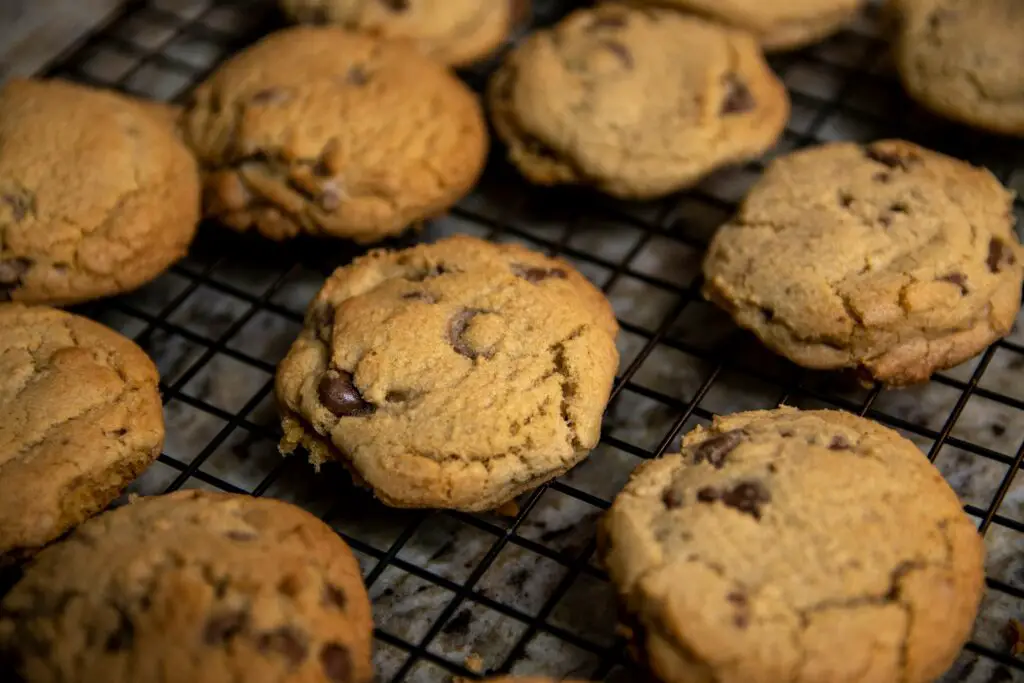There’s something magical about pulling warm chocolate chip cookies straight from the oven. Crispy edges. Gooey centers. Melted chocolate in every bite.
But here’s the thing—great cookies aren’t about luck. They’re about simple ingredients and smart little tweaks that make all the difference.
Whether you’re a first-timer or just tired of flat, sad-looking cookies, this guide’s got your back.
Let’s master the classic cookie—step-by-step.
Ingredients Matter: Choosing the Best for Flavor & Texture
Butter
Salted or unsalted? Go with unsalted for full control over the flavor. And temperature matters more than you think.
Room temperature butter creates light, airy cookies. Melted butter? It leads to chewier, flatter cookies. Choose based on the texture you’re after.
Sugars
Brown sugar adds moisture and a rich, caramel flavor. White sugar makes cookies crispier. Want soft and chewy? Use more brown.
Craving crunch? Lean into white. The balance between the two changes everything.
Flour
All-purpose flour is the go-to. However, if you prefer a more chewy texture, try bread flour.
It has more protein, which means more gluten—and that translates to a satisfyingly dense texture.
Chocolate
Chips are classic, but don’t stop there. Chunks give you pockets of melted goodness. Discs or chopped chocolate bars create dramatic pools and better distribution.
Want bakery-style vibes? Mix two types.
Eggs
Room temp eggs blend better with the dough and help with even texture. Cold eggs can shock the butter and throw everything off.
Quick fix: place eggs in a bowl of warm water for 5–10 minutes before using.
Vanilla & Salt
Don’t skip these. A dash of vanilla deepens flavor. A pinch of salt sharpens the sweetness and balances the chocolate. It’s like background music in a movie—you miss it when it’s not there.
Tools of the Trade (Optional but Game-Changing)
You can make amazing cookies with just a bowl and a spoon—but a few tools can take your baking from good to pro-level without the fuss.
Mixer Showdown
A stand mixer makes fast work of creaming butter and sugar. A hand mixer gets the job done just fine too.
No mixer? A wooden spoon and elbow grease still work—just expect a mini workout.
Baking Surface
Silicone baking mats give cookies a consistent bottom and are reusable. Parchment paper is a great backup—less mess, no sticking, and easy cleanup.
Cookie Scoop
Want every cookie to bake evenly and look like they came from a bakery? Use a cookie scoop. Uniform size means no underbaked middles or burnt edges.
Cooling Rack
Let cookies cool on the tray for a few minutes, then transfer them to a cooling rack. This keeps the bottoms from going soggy and helps them set up with the right texture.
Kitchen Scale
For precise measurements, weigh your ingredients using a kitchen scale. It’s how pro bakers avoid dry or doughy disasters. One extra tablespoon of flour can make or break a batch.
The Perfect Dough: Mixing Techniques That Matter
Making great cookie dough isn’t hard—but a few small technique tweaks can make a huge difference in flavor and texture.
Creaming Butter and Sugar
Don’t rush this part. Creaming means beating butter and sugar together until the mixture is light and fluffy—about 2–3 minutes with a mixer.
It whips in air, which helps your cookies rise and gives them that soft, tender bite.
Add Eggs One at a Time
Crack in one egg, mix, then add the next. Why? It ensures a smooth, even dough. Dumping both in at once can cause separation or uneven texture. It’s a small step that keeps things silky.
Fold in Dry Ingredients Gently
Dump in the flour and mix just until combined. Overmixing creates tough cookies (no one wants that).
Once you stop seeing flour streaks, you’re good. Less stirring = more tender cookies.
Stir in the Chocolate Last
Add your chocolate—chips, chunks, or both—at the very end. Use a spoon or spatula to fold them in gently so they don’t melt or break up too much.
Aim for even distribution without crushing the mix-ins.
Chill or Not to Chill? The Cold Truth
Here’s the deal: chilling your cookie dough is a total game-changer—but it’s not always required. It depends on the results you’re after.
Why Chill?
Chilled dough means less spreading, deeper flavor, and thicker, chewier cookies.
It gives the flour time to hydrate and the butter time to firm up—so your cookies bake up with gorgeous texture and rich, toffee-like flavor.
How Long Should You Chill?
For noticeable results, aim for at least 30 minutes. But if you want next-level flavor, chill the dough for 12 to 24 hours. Yes, it takes patience—but the payoff is real.
Freezer Hack
Scoop the dough into balls, freeze them raw, and stash them in a zip-top bag. Bake straight from frozen—just add 1–2 extra minutes to the bake time.
Fresh cookies on demand? Yes, please.
Baking Tips That Make or Break Cookies
Your dough might be perfect—but the bake can make or break your cookies. Here’s how to nail it every time.
Oven Temp: 350°F Isn’t One-Size-Fits-All
Yes, 350°F is the gold standard—but if your cookies are spreading too much or baking unevenly, try lowering to 325°F for a slower, chewier bake. Want crisp edges? Raise to 375°F for a faster set.
Bake Time = Texture Control
For soft, gooey cookies, pull them at 8–10 minutes, even if the centers look underbaked—they’ll finish setting as they cool. For crisper cookies, bake 11–13 minutes until the edges are firm and golden.
Middle Rack = Even Cookies
Always bake on the middle rack. The top rack can brown too fast. The bottom can burn. Middle keeps things balanced, especially when using parchment or silicone mats.
Edges Tell the Story
Don’t wait for the whole cookie to brown. Once the edges are golden and the centers look just barely set, pull them out. Trust the process—the texture will be perfect once cooled.
Cooling & Finishing Touches
The moment they’re out of the oven, the work’s not over. Cooling is part of the process—and a few final touches can make your cookies unforgettable.
Let Them Set Before Moving
Fresh from the oven, cookies are fragile. Let them sit on the baking tray for 5–10 minutes to firm up. Move them too soon, and they might fall apart or lose their shape.
Sea Salt = Flavor Magic
While they’re still warm, add a tiny sprinkle of flaky sea salt on top. It sharpens the sweetness and makes the chocolate pop. Just a pinch turns “good” into “wow.”
Texture Changes as They Cool
Cookies continue to bake and set as they cool. Soft centers will firm slightly, and edges will crisp up. Let them cool completely on a wire rack for the perfect balance of chew and crunch.
Flavor Variations (Optional but Delicious)
Once you’ve nailed the classic chocolate chip cookie, it’s time to have some fun. These easy add-ins can give your cookies a whole new personality.
Nutty Twist
Fold in ½ to 1 cup of chopped pecans or walnuts for crunch and a warm, toasty flavor. Toast them beforehand for even more depth.
Texture Boost
Want more chew? Try ½ cup of rolled oats. Craving something tropical? Add shredded coconut for a soft, sweet texture upgrade. These extras also help cookies hold their shape.
Sweet Swaps & Swirls
Mix it up with:
- Double chocolate: Swap ¼ cup of flour for cocoa powder.
- Peanut butter swirl: Add dollops of peanut butter to the top of each scoop before baking.
- Caramel bits or toffee pieces: Stir in ½ cup for pockets of melted sweetness.
Storage Tips & Freezing Instructions
Great cookies shouldn’t be a one-day wonder. Here’s how to keep them soft, stash extras, and enjoy that fresh-baked magic anytime.
Keep Them Soft for Days
Store cookies in an airtight container at room temp. Want to keep them extra soft? Drop a slice of bread in the container.
The cookies absorb the moisture from the bread, not the other way around. Replace the slice after a day or two.
Freeze Baked or Unbaked
- Baked cookies: Cool completely, then freeze in a single layer before transferring to a freezer bag. They’ll stay fresh for up to 2 months.
- Raw dough balls: Scoop, freeze on a tray, then bag. Bake straight from frozen—just add 1–2 minutes to the bake time.
Reheat for Fresh-Baked Vibes
Warm cookies in the microwave for 8–10 seconds or pop them in a 300°F oven for 3–5 minutes. The chocolate melts again. The texture revives. It’s like day one all over again.
Troubleshooting Common Cookie Problems
Even seasoned bakers hit cookie snags. Here’s how to fix the most common issues without tossing the whole batch.
Cookies Too Flat?
- Butter too warm or dough wasn’t chilled.
- Try chilling the dough for 30+ minutes.
- Add 1–2 tablespoons of flour next time for more structure.
Cookies Too Puffy?
- Overmeasured flour or cold dough.
- Use a kitchen scale if possible. Let dough warm slightly before baking for better spread.
Too Dry or Crumbly?
- Overbaked or too much flour.
- Next time, reduce bake time by a minute or swap some white sugar for brown (adds moisture).
Too Greasy?
- Butter may have melted too much during mixing.
- Chill dough and mix dry ingredients in gently. Don’t skip the creaming step.
Chocolate Chips Melting Into Puddles?
- Oven might be too hot.
- Use chunkier chocolate or stir it in cold to help it hold shape. Let cookies cool on tray to firm up.
Burnt Bottoms?
- Dark cookie sheets or low rack placement.
- Use parchment or silicone mats. Stick to the middle rack and check doneness early.
Final Words
Perfect chocolate chip cookies don’t just happen.
They’re the result of quality ingredients, simple techniques, and a bit of patience.
Try different tweaks. Play with textures. Make the recipe your own.
Baked a batch? Tag us in your cookie pics—we’d love to see!
FAQs
Can I substitute butter with oil?
You can—but expect a different texture. Oil makes cookies softer and more cake-like, while butter adds flavor and structure. If you swap, use slightly less oil than butter (about ¾ the amount).
What if I don’t have brown sugar?
Mix 1 cup white sugar with 1 tablespoon molasses for a quick DIY brown sugar. No molasses? You can use all white sugar, but your cookies may turn out a bit crisper and less chewy.
How do I make them gluten-free?
Use a 1:1 gluten-free baking flour blend (with xanthan gum included). The cookies might spread a little differently, but the taste holds up well. Chill the dough for best results.
Can I bake these in an air fryer?
Yes! Scoop smaller portions and bake at 320°F for 6–8 minutes. Don’t overcrowd the basket—leave space for spreading. It’s great for small batches or late-night cookie cravings.



